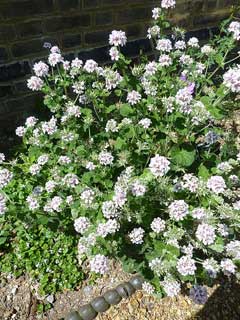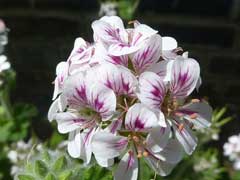 |
|
http://commons.wikimedia.org/wiki/User:Magnus_Manske |
 |
| http://commons.wikimedia.org/wiki/User:Magnus_Manske |
Translate this page:
Summary
Physical Characteristics

 Pelargonium_australe is a PERENNIAL growing to 0.3 m (1ft) by 1 m (3ft 3in).
Pelargonium_australe is a PERENNIAL growing to 0.3 m (1ft) by 1 m (3ft 3in).
See above for USDA hardiness. It is hardy to UK zone 9 and is frost tender. It is in flower from May to July. The species is hermaphrodite (has both male and female organs).
Suitable for: light (sandy) and medium (loamy) soils and prefers well-drained soil. Suitable pH: mildly acid, neutral and basic (mildly alkaline) soils. It cannot grow in the shade. It prefers dry or moist soil.
UK Hardiness Map
US Hardiness Map
Synonyms
Plant Habitats
Edible Uses
Root. No more details are given apart from a note that it is astringent[193].
References More on Edible Uses
Medicinal Uses
Plants For A Future can not take any responsibility for any adverse effects from the use of plants. Always seek advice from a professional before using a plant medicinally.
All parts of the plant are astringent[4, 193].
References More on Medicinal Uses
The Bookshop: Edible Plant Books
Our Latest books on Perennial Plants For Food Forests and Permaculture Gardens in paperback or digital formats.

Edible Tropical Plants
Food Forest Plants for Hotter Conditions: 250+ Plants For Tropical Food Forests & Permaculture Gardens.
More

Edible Temperate Plants
Plants for Your Food Forest: 500 Plants for Temperate Food Forests & Permaculture Gardens.
More

More Books
PFAF have eight books available in paperback and digital formats. Browse the shop for more information.
Shop Now
Other Uses
References More on Other Uses
Cultivation details
Requires a light well-drained neutral to alkaline soil in a sunny position[188, 200]. Prefers a sandy soil[260]. Plants are not very cold-hardy in Britain, tolerating temperatures down to about 0°c[260]. They generally require greenhouse protection but might succeed outdoors when grown in a very sheltered warm spot in the mildest parts of the country[1]. They can also be grown in containers that are placed outdoors in the summer and then brought into the greenhouse or conservatory for the winter[238]. The plants need to be kept fairly dry in the winter[200]. Very tolerant of pruning, they can be cut right down to the base in the autumn when bringing them back indoors, or in the spring to encourage lots of fresh growth[238]. A polymorphic species, the form from Tasmania is smaller in all parts with green leaves and red petioles[200].
References Carbon Farming Information and Carbon Sequestration Information
Temperature Converter
Type a value in the Celsius field to convert the value to Fahrenheit:
Fahrenheit:
The PFAF Bookshop
Plants For A Future have a number of books available in paperback and digital form. Book titles include Edible Plants, Edible Perennials, Edible Trees,Edible Shrubs, Woodland Gardening, and Temperate Food Forest Plants. Our new book is Food Forest Plants For Hotter Conditions (Tropical and Sub-Tropical).
Shop Now
Plant Propagation
Seed - best sown as soon as it is ripe in a greenhouse. Stored seed should be sown in early spring in a greenhouse. The seed germinates best with a minimum temperature of 13°c, germination usually taking place within 2 weeks though it sometimes takes some months[200]. Prick out the seedlings into individual pots when they are large enough to handle and grow them on in the greenhouse for at least their first winter. If trying them outdoors, plant them out in early summer and consider giving them extra protection during the winter. Cuttings succeed at almost any time in the growing season but early summer is the best time in order for the new plant to become established before winter.
Other Names
If available other names are mentioned here
Native Plant Search
Search over 900 plants ideal for food forests and permaculture gardens. Filter to search native plants to your area. The plants selected are the plants in our book 'Plants For Your Food Forest: 500 Plants for Temperate Food Forests and Permaculture Gardens, as well as plants chosen for our forthcoming related books for Tropical/Hot Wet Climates and Mediterranean/Hot Dry Climates. Native Plant Search
Found In
Countries where the plant has been found are listed here if the information is available
Weed Potential
Right plant wrong place. We are currently updating this section.
Please note that a plant may be invasive in one area but may not in your area so it’s worth checking.
Conservation Status
IUCN Red List of Threatened Plants Status :

Growth: S = slow M = medium F = fast. Soil: L = light (sandy) M = medium H = heavy (clay). pH: A = acid N = neutral B = basic (alkaline). Shade: F = full shade S = semi-shade N = no shade. Moisture: D = dry M = Moist We = wet Wa = water.

Expert comment
Author
Willd.
Botanical References
200265
Links / References
For a list of references used on this page please go here
Readers comment
| Add a comment |
|
If you have important information about this plant that may help other users please add a comment or link below. Only comments or links that are felt to be directly relevant to a plant will be included. If you think a comment/link or information contained on this page is inaccurate or misleading we would welcome your feedback at [email protected]. If you have questions about a plant please use the Forum on this website as we do not have the resources to answer questions ourselves.
* Please note: the comments by website users are not necessarily those held by PFAF and may give misleading or inaccurate information.
To leave a comment please Register or login here All comments need to be approved so will not appear immediately.
|
Subject : Pelargonium_australe
|
|
|
|